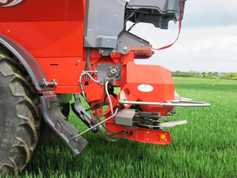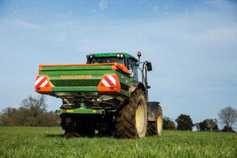It is always the simple things that farmers like best - the practical tools to make the job easier in the parlour or in the fields.
Milk quality is money in your pocket - it means a better milk price for you if it’s top grade. They are very simple and you have all heard about them but they are very worthwhile and most parlours should have all three. Unfortunately the usage of all three is relatively small in Ireland.
Clear identification is paramount if you are treating cows especially in the spring. Taking clean milk samples with no contamination is paramount if you want to find out whether a quarter has high cell count or not. The CMT (Californian Mastitis test) works and individual farmers will use it daily if they suspect a touch of mastitis. Many more will only use the CMT once they get back their milk recording results but often that can be too late.

Tool 1 - Clear identification – using straps or markers
Identifying cows that are milking on three teats or who should be milked last is very important and using the leg strap pictured can make the job a lot easier.
The strap (or similar) can be purchased in most co-ops. There are a variety of different colours available and some farmers will use different colours (blue, red, green etc) to identify cows that are milking on three teats all the time or cows that are being treated with antibiotics. The straps are very easy to use and fairly robust.
Some farmers complained to me before about Velcro leg straps that sometimes used to go missing as the cow might brush her leg off a briar or a bush and the Velcro strap would get dislodged. No chance of a low hanging briar or bush taking this sort of strap off.
Tool 2 – Taking milk samples properly
Some farmers will take milk samples from cows to make sure that all traces of antibiotics are gone from the cow before allowing milk back into the bulk tank. More will sample heifers or cows through the year to identify what quarter is causing the elevated cell count. More farmers will sample infected quarters to se what type of bacteria or bug is causing the elevated cell count.
It is very important that the person in the laboratory gets the sample in a clean and proper manner. If you don’t take the sample properly or mark the bottle properly then it is a waste of time sending in the sample.

Step 1 – Write the details on the bottle before you take any samples. Have it all organised well before you go near the parlour. Preferably use a pencil as sometimes markers and pens can smudge if they become wet when taking the sample.Step 2 – Always use methylated spirits and if you don’t have this use teat dip to wash the teat and clean off any dirt on the teat.Step 3 – Always hold the bottle in the corner of your hand between your thumb and your index finger with the lid also in your hand turned down (not turned up towards the udder when you are taking a sample). Once the lid is faced down no dirt from the udder can fall into the lid.Step 4 - Sample all cows in the same fashion. Set up a routine Right front = A, Right hind = B, Left front = C, Left hind = D and the head is always universal in front.Step 5 – Use gloves when taking the samples – easier to wash and easier to see dirt on them.Step 6 – Complete the sample submission form showing the cow number and details of sample.Tool 3 – CMT paddle

You can buy the CMT test kit in most local co-ops. If you want to work with a cow on treatment or testing always draft her out, hold her back, and milk her in the last row. This means you can focus on doing whatever work you have to without holding up the rest of the herd or upsetting the work routine in the parlour. It also takes the pressure to make a hurried decision.
How to use:
Step 1 – Always disinfect the teat first.Step 2 - you take a sample of milk from each quarter always face the paddle the same way so that when you take the paddle out from under the cow you know what quarter corresponds to what paddle.Step 3 – Once you have two to three mls of milk in each paddle squirt in reagent. One push is equal to 3 ml in container.Step 4 – Mix and the high cell count milk will thicken and turn colour. You now know what quarter you have to treat or dry off etc.
It is always the simple things that farmers like best - the practical tools to make the job easier in the parlour or in the fields.
Milk quality is money in your pocket - it means a better milk price for you if it’s top grade. They are very simple and you have all heard about them but they are very worthwhile and most parlours should have all three. Unfortunately the usage of all three is relatively small in Ireland.
Clear identification is paramount if you are treating cows especially in the spring. Taking clean milk samples with no contamination is paramount if you want to find out whether a quarter has high cell count or not. The CMT (Californian Mastitis test) works and individual farmers will use it daily if they suspect a touch of mastitis. Many more will only use the CMT once they get back their milk recording results but often that can be too late.

Tool 1 - Clear identification – using straps or markers
Identifying cows that are milking on three teats or who should be milked last is very important and using the leg strap pictured can make the job a lot easier.
The strap (or similar) can be purchased in most co-ops. There are a variety of different colours available and some farmers will use different colours (blue, red, green etc) to identify cows that are milking on three teats all the time or cows that are being treated with antibiotics. The straps are very easy to use and fairly robust.
Some farmers complained to me before about Velcro leg straps that sometimes used to go missing as the cow might brush her leg off a briar or a bush and the Velcro strap would get dislodged. No chance of a low hanging briar or bush taking this sort of strap off.
Tool 2 – Taking milk samples properly
Some farmers will take milk samples from cows to make sure that all traces of antibiotics are gone from the cow before allowing milk back into the bulk tank. More will sample heifers or cows through the year to identify what quarter is causing the elevated cell count. More farmers will sample infected quarters to se what type of bacteria or bug is causing the elevated cell count.
It is very important that the person in the laboratory gets the sample in a clean and proper manner. If you don’t take the sample properly or mark the bottle properly then it is a waste of time sending in the sample.

Step 1 – Write the details on the bottle before you take any samples. Have it all organised well before you go near the parlour. Preferably use a pencil as sometimes markers and pens can smudge if they become wet when taking the sample.Step 2 – Always use methylated spirits and if you don’t have this use teat dip to wash the teat and clean off any dirt on the teat.Step 3 – Always hold the bottle in the corner of your hand between your thumb and your index finger with the lid also in your hand turned down (not turned up towards the udder when you are taking a sample). Once the lid is faced down no dirt from the udder can fall into the lid.Step 4 - Sample all cows in the same fashion. Set up a routine Right front = A, Right hind = B, Left front = C, Left hind = D and the head is always universal in front.Step 5 – Use gloves when taking the samples – easier to wash and easier to see dirt on them.Step 6 – Complete the sample submission form showing the cow number and details of sample.Tool 3 – CMT paddle

You can buy the CMT test kit in most local co-ops. If you want to work with a cow on treatment or testing always draft her out, hold her back, and milk her in the last row. This means you can focus on doing whatever work you have to without holding up the rest of the herd or upsetting the work routine in the parlour. It also takes the pressure to make a hurried decision.
How to use:
Step 1 – Always disinfect the teat first.Step 2 - you take a sample of milk from each quarter always face the paddle the same way so that when you take the paddle out from under the cow you know what quarter corresponds to what paddle.Step 3 – Once you have two to three mls of milk in each paddle squirt in reagent. One push is equal to 3 ml in container.Step 4 – Mix and the high cell count milk will thicken and turn colour. You now know what quarter you have to treat or dry off etc. 








 This is a subscriber-only article
This is a subscriber-only article












SHARING OPTIONS: